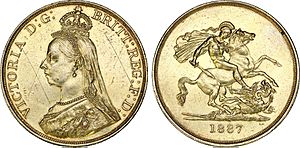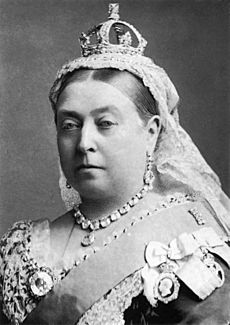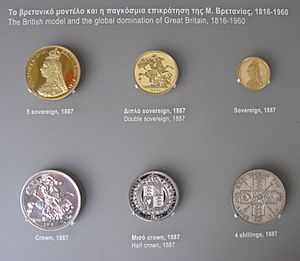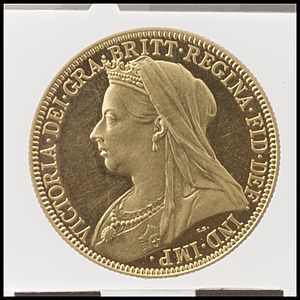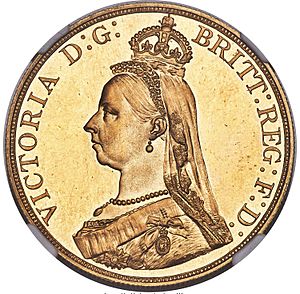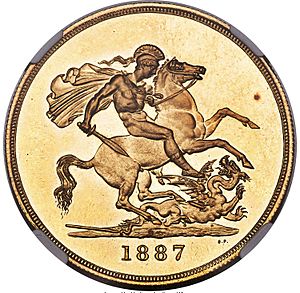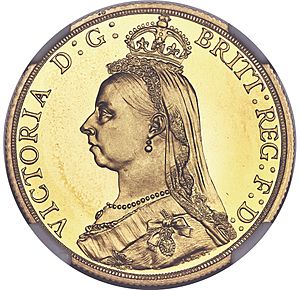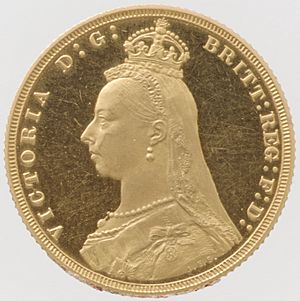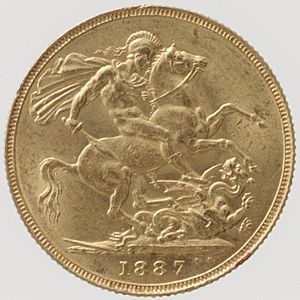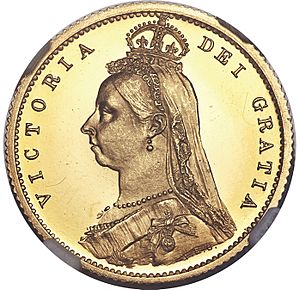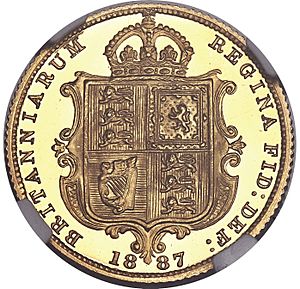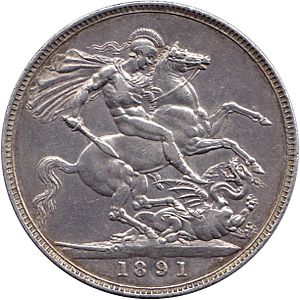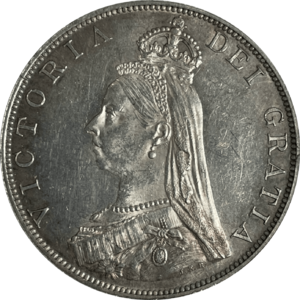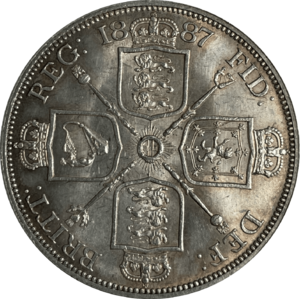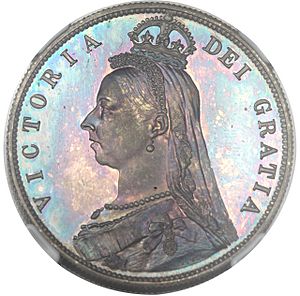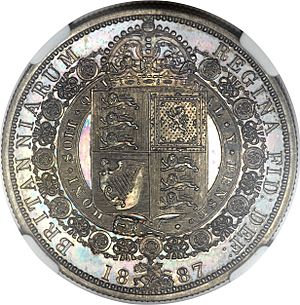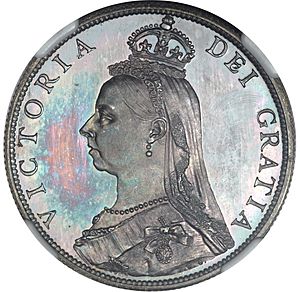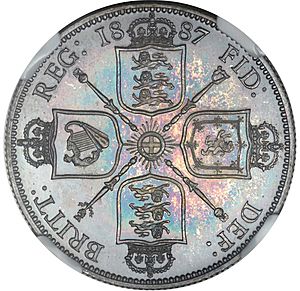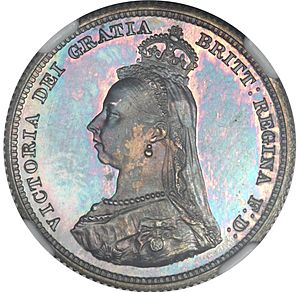Jubilee coinage facts for kids
The Jubilee coinage refers to British coins made with a special picture of Queen Victoria on the front. This design was created by Joseph Edgar Boehm. These coins were first made in 1887 for silver and gold money that people used every day. They were also used for Maundy coinage starting in 1888.
People often made fun of the coin's design because Queen Victoria was shown wearing a crown that looked too small. Because of this, the design was changed in 1893. This series of coins included the only time the double florin coin was ever made (from 1887 to 1890). Also, 1888 was the last year the groat (or fourpence coin) was made for general use, even though it was meant for British Guiana. No bronze coins, like the penny, were made with the Jubilee design.
In 1879, Joseph Edgar Boehm was chosen to create a new picture of Victoria for coins. Even though the queen was 60 years old that year, some coins still showed her as she looked 40 years earlier. Boehm worked on the project on and off, and it took several years to finish. The queen finally approved the design in early 1887, and the new coins were prepared. Some of the pictures on the back of the coins were also changed at this time. These new designs showed royal symbols and were carved by Leonard Charles Wyon.
When the new coins came out in June 1887, they were popular souvenirs for Queen Victoria's Golden Jubilee. However, people criticized them because the crown looked too small. Also, the back of the coins did not clearly state their value. For example, the sixpence coin was sometimes covered in gold by dishonest people to make it look like a more valuable half sovereign. Because of this, the Royal Mint quickly stopped making the sixpence with that design. They went back to an older design that clearly showed its value. Within a year, the Royal Mint started thinking about replacing the Jubilee coins. This might have happened faster after Boehm died in 1890. A group was formed to find new designs, and the Old Head coinage, with a new picture by Thomas Brock, started being made in 1893.
Contents
Creating the Jubilee Coin Designs
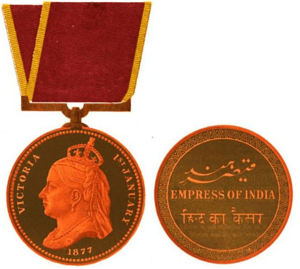
By the late 1870s, most British coins still showed Queen Victoria as she looked in 1838. This was the year after she became queen at age 18. Since the queen was now nearly 60, she no longer looked like the picture on the coins. In February 1879, the queen's private secretary, Sir Henry Ponsonby, told Charles Fremantle, who was in charge of the Royal Mint, that Joseph Edgar Boehm would create a new picture of the queen for coins. Boehm was born in Austria and was a skilled sculptor who had already made several artworks for the royal family.
There was no rush for Boehm to finish the design. He often put the portrait aside to work on other projects. In June 1879, Queen Victoria wrote in her diary that she had "sat to Böhm for a Bas Relief" (a type of sculpture). By August, the design of her head was said to be done. However, in November, Boehm apologized for not making more progress.
On January 1, 1880, Boehm wrote again, saying he had finished several small models. He mentioned a small crown he had placed on Victoria's head. This crown was similar to one seen on the 1877 Empress of India Medal. Fremantle wasn't sure about this small crown. He asked an expert if there were other coins in history with such a crown. The expert replied that crowns on ancient Greek coins looked like they were meant to be worn and wouldn't fall off easily.
In January 1880, the queen's daughter, Princess Louise, saw Boehm's work and suggested a bigger crown. On February 20, Victoria visited the sculptor and approved the changed crown. Fremantle visited Boehm three days later. Still worried about the crown, he asked for advice from the Tower of London and the College of Arms. Victoria sat for Boehm again on February 28. The work was far enough along that Fremantle suggested the Royal Mint's engraver, Leonard Charles Wyon, prepare the coin molds.
Wyon made the molds, and test coins were made several times over the next three years. But no design pleased everyone. Boehm's design, with a crown that fit Victoria's head better, was used for the Afghanistan Medal in 1881. By the end of 1882, Fremantle suggested starting over, and Boehm agreed.
For this second try, Boehm brought in a sculptor from Vienna, Carl Radnitzky, who had taught him. Radnitzky said one of his students did some of the work. In August 1884, Fremantle had the finance minister show a test half crown coin to Victoria. She thought it looked like her but didn't like how the veil was shown. She also said she preferred the old coins. By this time, the smaller crown was back on her image. More changes were made, and more molds were sent from Vienna.
In 1885, Leonard Wyon rejoined the project. By June 1886, the project was advanced enough that Fremantle told Boehm it would be good to have the new coins ready for Queen Victoria's Golden Jubilee in 1887. The queen approved the new picture in July. More changes were needed, and it wasn't until March 1887 that the new finance minister, George Goschen, approved the coins. Wyon prepared the final molds from Boehm's designs. The queen then gave her final approval. She wanted the coins to show something about the Jubilee, but Fremantle said no. He wanted to send the molds to the Australian mints right away. He said that since the coins were made in the Jubilee year, they would always be linked to the Jubilee.
What the Jubilee Coins Looked Like
On the front of the Jubilee coins, Queen Victoria wears her small diamond crown. She had bought this crown because she didn't want to wear a heavier one. It was the crown she liked to wear at the time, and it appears in other pictures of her from that period.
However, this crown quickly became a problem. Many people criticized Boehm's portrait because the "tiny crown [looked] in danger of tumbling off the back of the queen's head." One historian called the effect of the small crown "ludicrous" (ridiculous). Another expert, Kevin Clancy, said:
The small crown, which Victoria actually liked, is often seen as the main problem with the design. But it wasn't the only weak point. Boehm was a good sculptor, and he may have wanted to make a true likeness. But the crown, her widow's veil, and the way her bust was cut off, made people notice Victoria's sharp profile.
Another coin expert, Howard Linecar, called the Jubilee head coins "conservative in design, except only for that unfortunate crowned bust." Richard Lobel said that "the small crown placed on the back of the queen's head made her look a bit foolish." Some writers even described the Jubilee head as "perhaps the least flattering of Victoria's coin portraits." They said it showed a "middle-aged rather jowly looking queen wearing a disproportionately small crown on top of her widow's veil."
The coin also shows Victoria wearing a widow's veil. After her husband, Prince Albert, died in 1861, she stayed in mourning, and her veil would have been black. The veil comes down from a cap worn under her crown. The queen also has a pearl necklace and an earring. She wears the ribbon and star of the Order of the Garter and the badge of the Order of the Crown of India. The artist's initials, JEB, are on the bottom part of her bust.
For the back of the coins, Fremantle, who was in charge of the Royal Mint, brought back some of the best old royal designs. He thought that designs showing the coin's value inside a wreath looked "feeble" (weak). So, he chose artistic designs from the Great Recoinage of 1816–1817 or even older. These were carved by Wyon.
In 1873, Fremantle had brought back Benedetto Pistrucci's 1817 design of Saint George and the Dragon for the sovereign coin. This design appeared on the gold sovereign, double sovereign, and five-pound piece of the Jubilee coinage. It was also on the silver crown, or five-shilling coin. Starting with the Jubilee coinage, a plume (a feather-like decoration) was added back to Pistrucci's design. It was in his original work but had been removed later.
The sixpence, shilling, florin, half crown, half sovereign, and the new double florin coin all had different versions of the royal symbols of the United Kingdom. For example, the half sovereign had a "garnished Shield surmounted by the Royal Crown" (a decorated shield with a crown on top). The half crown had a "plain Shield surrounded by the Garter, bearing the Motto 'Honi soit qui mal y pense' and the Collar of the Garter." The half sovereign's design was a small change from earlier Victorian half sovereigns. Each of the coins from the sixpence up had the year it was made, but none of them stated the coin's value in words. The sixpence had shown its value inside a wreath since 1831. This was because it was the same size as the half sovereign and was sometimes illegally covered in gold to pass as one.
The silver threepence and the Maundy coinage (which got the new front design in 1888) kept their old designs. These designs, used since 1822, showed a wreathed and crowned number for their value. However, the crown was changed, and the Maundy twopence had a different style number 2. Leonard Wyon made these changes, and these designs are still used for Maundy coins today.
No changes were made to the bronze coins (the penny and its smaller parts) because there were already many of them. However, test coins of the penny, halfpenny, and farthing were made with designs similar to Boehm's. The Jubilee coins had a shortened Latin phrase: "VICTORIA DEI GRATIA BRITANNIARUM REGINA FIDEI DEFENSOR." This means "Victoria by the grace of God queen of the British territories, Defender of the Faith." The word "Britanniarum" was shortened to "BRITT" with two T's. This was because a scholar pointed out that the abbreviation of a Latin plural word should end with a double consonant.
Why the Jubilee Coins Were Replaced
The double florin coin was not very popular. Some people wondered why such a coin was needed, or complained that it was too similar in size to the crown coin. There were stories of pub owners and their staff losing money because they mistook the double florin for a five-shilling coin. Because of this, it was nicknamed the "Barmaid's Ruin." The government tried to make it more popular by including it in workers' paychecks. However, making these coins was stopped for good in August 1890.
When Boehm died in December 1890, the Royal Mint was free to consider new coin designs without upsetting the queen's favorite sculptor. In February 1891, the finance minister, Goschen, created a committee to look at coin designs. Sir John Lubbock was the chairman, and it included Fremantle and other important people. The committee's job was to "look at the designs on the coins made in 1887, and any suggested improvements. They were also to recommend which coins, if any, should have their values written on them in words and numbers." At their first meeting on February 12, 1891, the committee suggested that the double florin should not be made anymore. Goschen confirmed this in parliament on May 25.
A competition was held, and several sculptors were asked to submit two versions of a new design for the front of the coins by October 31. A design by Sir Thomas Brock was chosen. It showed Victoria wearing a special headband (diadem) and a veil. The committee decided to keep Pistrucci's George and Dragon design on the coins it was already on. They also decided to add it to the half sovereign. New designs for the back of the other coins (sixpence and above) were chosen. Some were by Brock and some by another artist named Poynter. The committee also recommended that the value should appear on all coins from the threepence to the half crown.
A royal announcement for the new coins was made on January 30, 1893, and the new coins were well-received. Some 1893 sovereigns with Boehm's design were still made at the Australian mints. Half sovereigns of that type were made in London and Australia. For silver coins, some 1893 sixpences and threepence coins with Boehm's design were made in London. But other than these, the Jubilee coinage was no longer produced.
List of Jubilee Head Coins
| Coin Name | Front (Obverse) | Back (Reverse) | Back Design Artist and First Year Used | Years Made with Jubilee Front and Last Use of Back Design |
|---|---|---|---|---|
| Five-pound piece | Benedetto Pistrucci (1887) | 1887 (London and Sydney mints). Back design used until 2023. | ||
| Double sovereign | Benedetto Pistrucci (1823) | 1887 (London and Sydney mints). Back design used until 2023. | ||
| Sovereign | Benedetto Pistrucci (1817, changed in 1821) | 1887–1892 (London Mint) 1887–1893 (Melbourne Mint) 1887–1893 (Sydney Mint) Back design used until 2023. |
||
| Half sovereign | Leonard Charles Wyon (1887 change of 1838 design by Jean Baptiste Merlen) | 1887, 1890–1893 (London Mint) 1887, 1893 (Melbourne Mint) 1887, 1889, 1891 (Sydney Mint) |
||
| Crown | Benedetto Pistrucci (1818, changed in 1821) | 1887–1892. Back design used until 1951. | ||
| Double florin | Leonard Charles Wyon (1887) | 1887–1890 | ||
| Half crown | Leonard Charles Wyon (1887) | 1887–1892 | ||
| Florin | Leonard Charles Wyon (1887) | 1887–1892 | ||
| Shilling | Leonard Charles Wyon (1887) | 1887–1892 | ||
| Sixpence (withdrawn type) | Leonard Charles Wyon (1887) | 1887 | ||
| Sixpence | Leonard Charles Wyon (1887 change of 1831 design by Jean Baptiste Merlen) | 1887–1893. Back design used until 1910. | ||
| Groat (fourpence) | William Wyon (1836) | 1888 | ||
| Threepence | Jean Baptiste Merlen (1822). Crown redesigned 1887 by Leonard Charles Wyon | 1887–1893. Back design used until 1926. | ||
| Maundy coinage | Jean Baptiste Merlen (1822). Crown redesigned 1888 by Leonard Charles Wyon. | 1888–1892. Back design still used as of 2023. |


